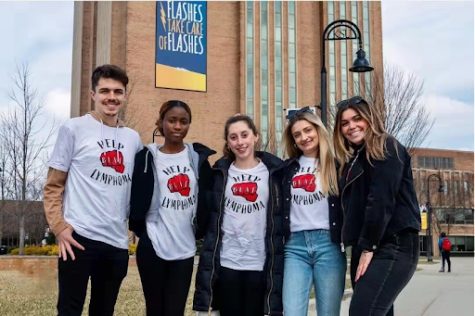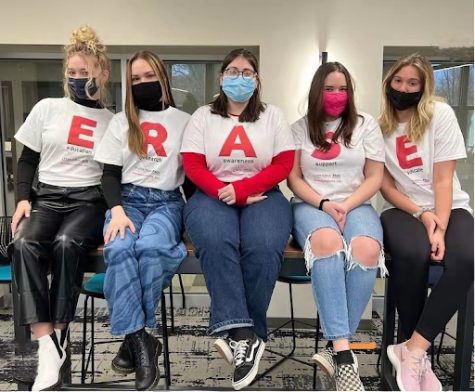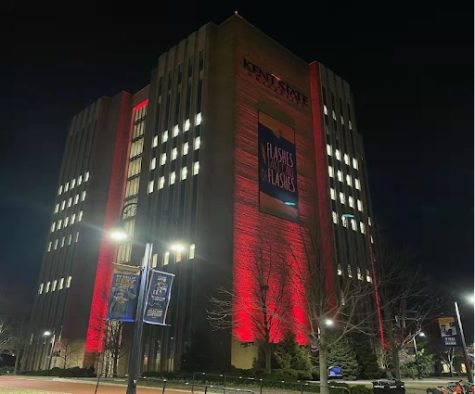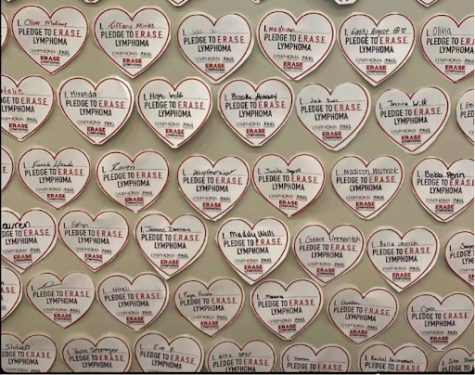Kent State students compete in national public relations case study competition
March 18, 2022
Lighting up the library, having people sign paper hearts and hosting a trivia night were some of the strategies the Bateman teams used to raise awareness for the Lymphoma Research Foundation.
Bateman teams, the competition teams for a national public relations case study program, completed their events before March 11. The teams worked to raise awareness, connect people in need with useful resources. They impacted others and gave back to the community while competing.
The annual competition is hosted by the Public Relations Students Society of America for public relations students across the nation.
PRSSA partners with an organization for each year’s competition. This year’s one is the nonprofit Lymphoma Research Foundation.
The competition aims to raise awareness of adolescent and young adult lymphoma on campus and in the local community.
For this year’s competition, Kent State PR professors tried something new with recruiting younger students to work with older ones.
In addition, they also expanded the selection of participants to gain different views.
“We have some PR minors as part of this, so I think that also brought a new and interesting perspective on the campaigns,” said Stefanie Moore, a media and journalism professor in charge of Kent State Bateman teams.

Kent has two teams in the competition as usual: Gold and Blue. Members of the Gold team are Morgan Cummings, Emily King, Austin Monigold, Tamra McMillion and Maggie Werren.
Members of the Blue team are Jordyn Forkell, Maddy Haberberger, Genevieve Krejci, Yarillis Sotomayor and Chloe Zofchak. The teams started work in November 2021.
The Gold team used its campaign “BEAT Lymphoma” to spread awareness about the Lymphoma Research society and its target groups.
The Gold targets students in the Kent State campus area, especially the College of Communication and Information.
“We chose them because they are very important people in furthering their career to help spread

the ideas of them from research and society in non-profits,” said Tamra McMillion, a junior public relations major on Gold.
The team members organized events to raise the awareness of their audience. They also created an Instagram account and a TikTok account facing the public.
Gold distributed flyers and had people pledge to support lymphoma at a hockey game and a women’s basketball game.
“We had signs that said ‘I advocate for,’ so people could write somebody that they know has had cancer,” said Maggie Werren, a junior public relations member of Gold. “We hold up the signs and went around to announce during the halftime.”
After these events, they even received donations that they didn’t expect, said Emily King, a sophomore public relations major on Gold.
From March 7 to March 11, they held “Beat Lymphoma Week.”

Their activities included lighting the library red, tabling in White Hall, punching a wall with a red fist in the Student Center to pledge, entering a PR classroom to have a presentation and having a virtual Kahoot game.
“Lighting the library is our biggest one,” said Austin Monigold, a junior public relations major on Gold. “We think that will help generate a lot of awareness on campus.”
The most important part of the whole campaign is to help connect people in need with cancer resources, Monigold said.
The Blue team also had its campaign, “ERASE Lymphoma,” which means using education, research, awareness and support to eradicate the disease.
The team members raised awareness through social media and face-to-face events, including a trivia night and an event at Northeast Ohio Medical University. They also spent over 26 hours of tabling around campus trying to get people to sign pledges.
Their target audience is medical students in Kent and young adults in the Kent State community, as well as businesses in downtown Kent.
“We chose them because that’s the age range, 15 to 39, which is affected by lymphoma the most,” said Chloe Zofchak, a junior public relations major on Blue. “Also, we want medical students to create a bond and a positive connection with the Lymphoma Research Foundation since they are the doctors and nurses of tomorrow.”
They hosted trivia night on March 3 to test attendees’ medical drama knowledge.
“We invited the public health student organization to speak and invited our target audience to come and learn more about lymphoma presentation and some fun interactive trivia game,” said Jordyn Forkell, a senior fashion merchandising major on Blue.
The NEOMED event was held on March 9. The Blue team collaborated with the Committee of Student Clinical Research at NEOMED’s campus to connect with medical students and encourage them to pursue a professional relationship with the Lymphoma Research Foundation.

The team also had hearts made of paper that individuals who want to be an advocate to support lymphoma patients and families signed. They put up those hearts on a wall of Henderson Hall for public display. In addition, they went to sporting events and spread these hearts into the MAC during a basketball game.
“We get almost 300 hearts signed by Kent State students,” said Genevieve Krejci, a sophomore public relations major on Blue. “It’s taken a lot of time.”
Gold and Blue both had many challenges in their events, but they eventually overcame those difficulties and succeeded in reaching their objectives.
“We’ve been doing so much research, consistently with doing tactics,” Gold’s member King said. “ However, we didn’t realize how much primary research we should have done before January when we weren’t on campus.”
Reaching people to attend events was also difficult, Werren on Gold said.
The Blue team also encountered similar situations.
“A lot of our plans fell through, but we found such creative ways to come back and still meet our objectives,” Blue’s member Krejci said. “I think we’ve made some amazing bonds and connections that we never would have had without those things failing.
The whole competition is nearing its end. The two teams will submit their case books of at least 58 pages including their research results, situation analysis, objectives, tactics, timeline and other things they have done by March 28 at 2 p.m.
Three finalist teams will be notified by PRSSA in April. The winning teams will be recognized during the PRSSA 2022 International Conference in October.
Chong Chen is a reporter. Contact her at [email protected].
























